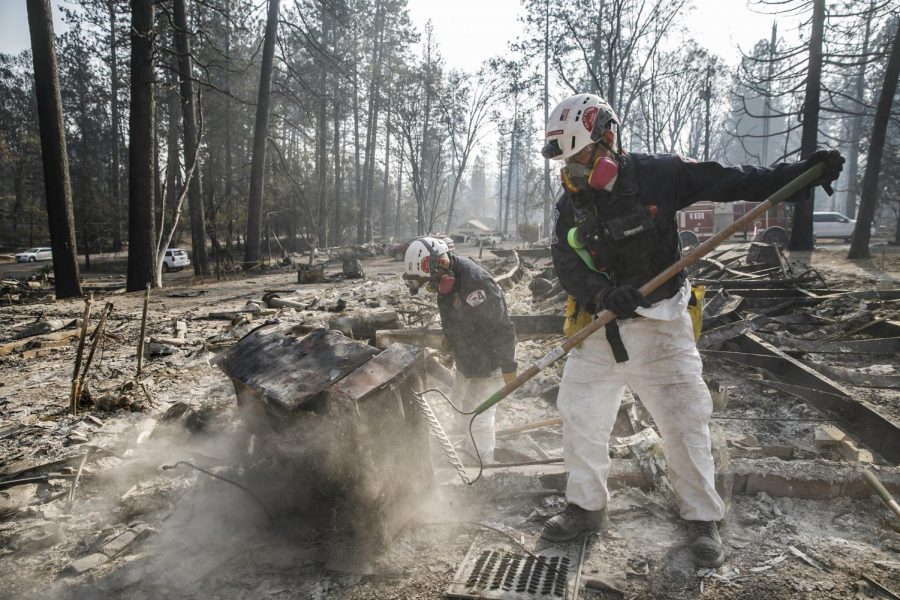Students react to wildfires in California
The death toll in California has reached 87 due to wildfires. The region remains one of the most conducive to fires in the U.S.
A search and rescue team comb through debris for human remains after the Camp Fire destroyed most of Paradise, California, on Nov. 20, 2018. (Marcus Yam/Los Angeles Times/TNS)
November 25, 2018
Growing up in California, University of Iowa freshman Eliza Steere said she had a box of her favorite things packed in case she had to evacuate the family home because of a fire.
“It’s just the reality of growing up in California,” she said.
This year’s wildfire season in California has been the most destructive, with a total of 7,579 fires burning, according to the National Interagency Fire Center.
The Camp Fire in Northern California has killed at least 87 people, destroyed residences and businesses, and torn families apart. The earlier Mendocino Complex Fire was the largest complex fire in the state’s history.
“We are lucky in the sense that we’re in the opposite end of the fire,” Steere said. “I am probably about an hour away from there.”
Growing up in California, she said, she has accepted fires as a part of her life.
“When we left in August, we had fires going because of the drought. It is not surprising,” she said. “It is sad to see the destruction … and everyone is not able to grab everything.”
People just take their belongings and start running during an evacuation, she said, and many don’t know where they’re going.
Things are worse, she said, because water that is saved is now going to be used to fight the fires, increasing chances of another drought.
“I was trying to explain to people when I first got here [that] I didn’t know what rain was,” she said. “I didn’t own an umbrella or have rain boots or anything, just because we don’t get rain in California.”
Steere conducted donation drives over Thanksgiving break when she went back home to help firefighters collect items, such as food, sanitizers, and clothes.
UI Associate Professor Frank Weirich of the Earth and Environmental Sciences Department, who studies the climate in California, noted that the state is no stranger to wildfires.
“Fires are a normal part of the landscape in California,” he said. “They have taken place for thousands of years. They can be caused by natural or human activities.”
RELATED: 10 years later, the collective memory of the 2008 flood remains
Lightning is one of the main causes of fires, Weirich said. These days, however, around half the fires are human-caused. A large portion of those can be attributed to arson, he said, but a lot of times, it can be accidental.
“The conditions in California are more conducive to fires,” he said. “The landscape is very rugged, which makes it difficult to fight a fire. You also have a particular kind of vegetation that is very effective at carrying fires.”
Because of the growing population, he said, people are building residences in the hills and foothills, where the fires originate, and that worsens the situation.
There are prescribed fire burns in California that aim to reduce the harm posed by wildfires, he said. The idea is that fires are set artificially, under controlled circumstances, to burn off the fuel.
“It aims to reduce fuel so that it doesn’t get built up over the years,” he said.
Iowa City native Abby Smith, a freshman at the University of California-Berkeley studying public health, said the climate there doesn’t resemble that of Iowa.
“It has been a change, because there aren’t four seasons here the way there are in Iowa,” she said. “It has been a different experience because it hasn’t rained yet.”
The air-quality worsened because of the fires in the north, she said, even at her home a couple hours away from the blaze.
“This is one of my first actual experiences in effect of climate change,” she said. “… You can see the pollution in the air. The most scary part is that there can be an environment that cannot provide for everyone.”






